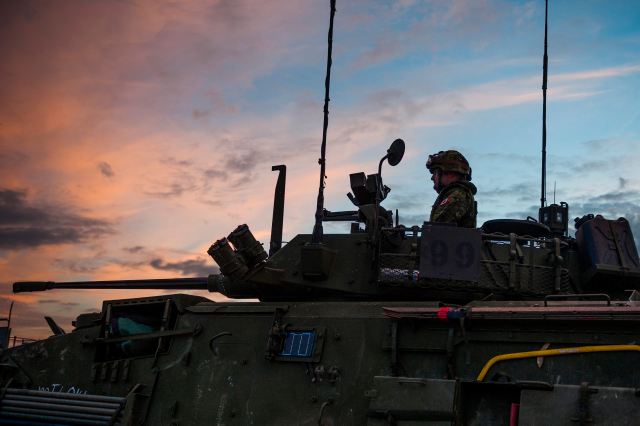Canadian Army communications specialists involved in NATO Exercise TRIDENT JUNCTURE 15 11112152
|
|
|||
|
Armies in the world - Canada
|
|||
|
|
|||
| Canadian Army communications specialists involved in NATO Exercise TRIDENT JUNCTURE 15. | |||
|
Canadian Army communications specialists involved in Exercise TRIDENT JUNCTURE 15 are coming home with experience and knowledge that will improve how they and other organizations respond to domestic emergencies.
|
|||
|
|
|||
 A member of the multinational brigade from 5 Canadian Mechanized Brigade-Group sits in the turret of a Light Armoured Vehicle III, in Santa Margarida, Portugal, during JOINTEX 15 as part of NATO’s exercise Trident Juncture 15 on October 30, 2015. Photo by: Sgt Sebastien Frechette A member of the multinational brigade from 5 Canadian Mechanized Brigade-Group sits in the turret of a Light Armoured Vehicle III, in Santa Margarida, Portugal, during JOINTEX 15 as part of NATO’s exercise Trident Juncture 15 on October 30, 2015. Photo by: Sgt Sebastien Frechette |
|||
|
|
|||
|
TRIDENT JUNCTURE 15, which took place from October 21 to November 6 in Spain, Italy and Portugal, was the largest NATO exercise in more than a decade. It simulated an attack on the Mediterranean region of Western Europe to test the participating countries’ abilities to work together.
The exercise was both a teaching and a learning experience for the Canadian Army, said Captain François Fortin, an operations officer for 5 Headquarters and Signal Squadron, a unit of 5 Canadian Mechanized Brigade Group (5 CMBG). TRIDENT JUNCTURE 15, he added, also provided the opportunity to test a device known simply as a ‘bridge,’ which makes military-style VHF radios compatible when they are using different frequencies. While there is a de facto NATO standard, Capt Fortin, explained that not all NATO nations have radios that use it. “Military radios are not like the radio in your car,” he explained. “It’s really different now because, first of all, there are a lot of these radios that can pass data on a wave. So the waveforms they’re using are different from one system to the other. The most-used waveform in NATO is based on SINCGARS (Single Channel Ground and Airborne Radio System), which is the American system.” There are many companies manufacturing bridges, Capt Fortin said, and they are small, simple and inexpensive. Not only did they prove successful in enabling communications during TRIDENT JUNCTURE 15, but further testing is planned here at home to ensure the same ease of communication between different organizations responding to natural disasters or other emergencies in Canada. “We still have some tweaking, some minor technical stuff to do,” he added. “But we’ll keep on working with and using it, especially with provincial public safety organizations. We want to start using it with them and have a couple of exercises where we’re going to use their network and our network and all talk together.” Capt Fortin said he regarded TRIDENT JUNCTURE 15 as a success and as a showcase for Canada’s strengths and readiness. “5 CMBG was leading a lot of different elements and I think we showed what we’re able to do in terms of leadership and solving problems.” |
|||


























